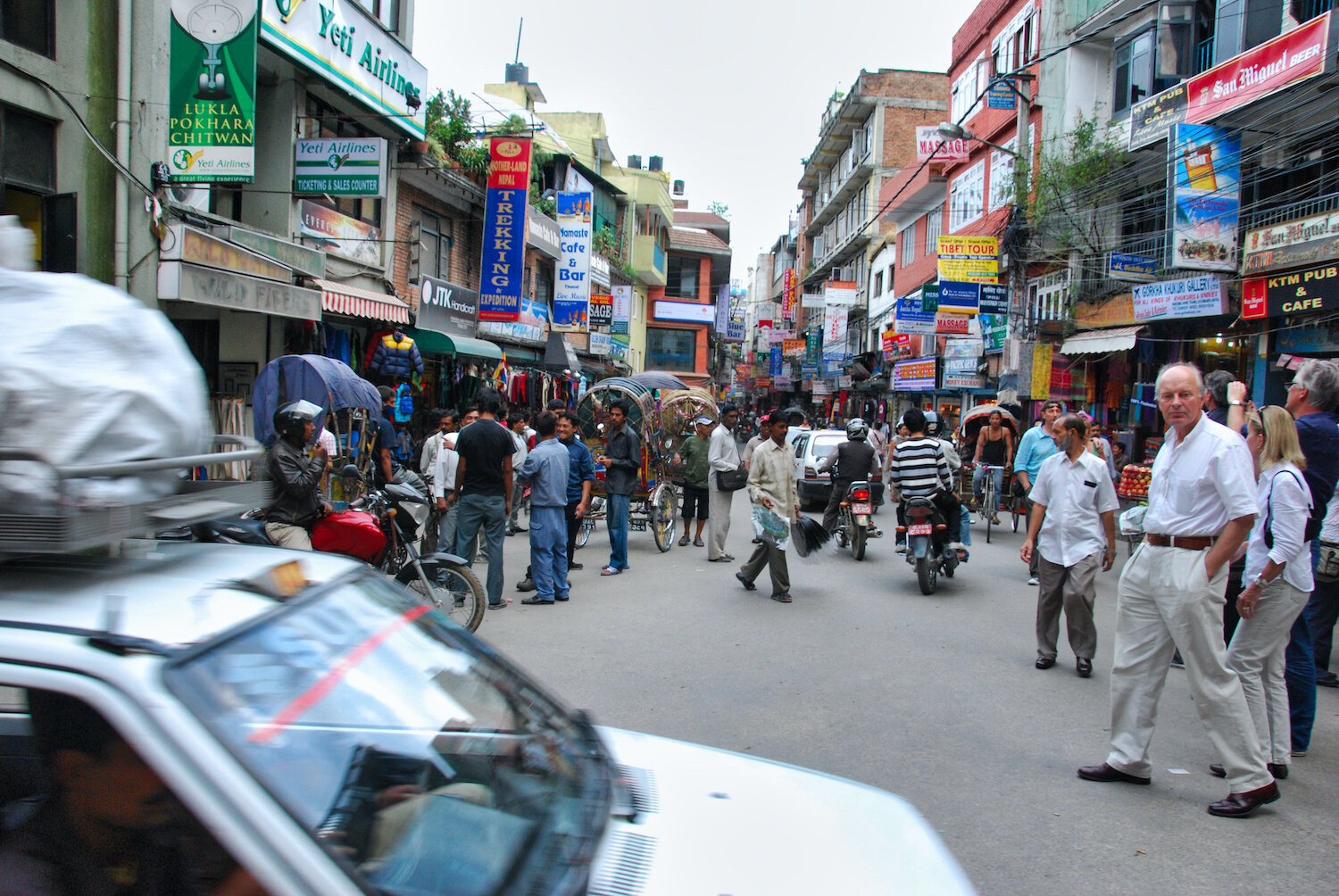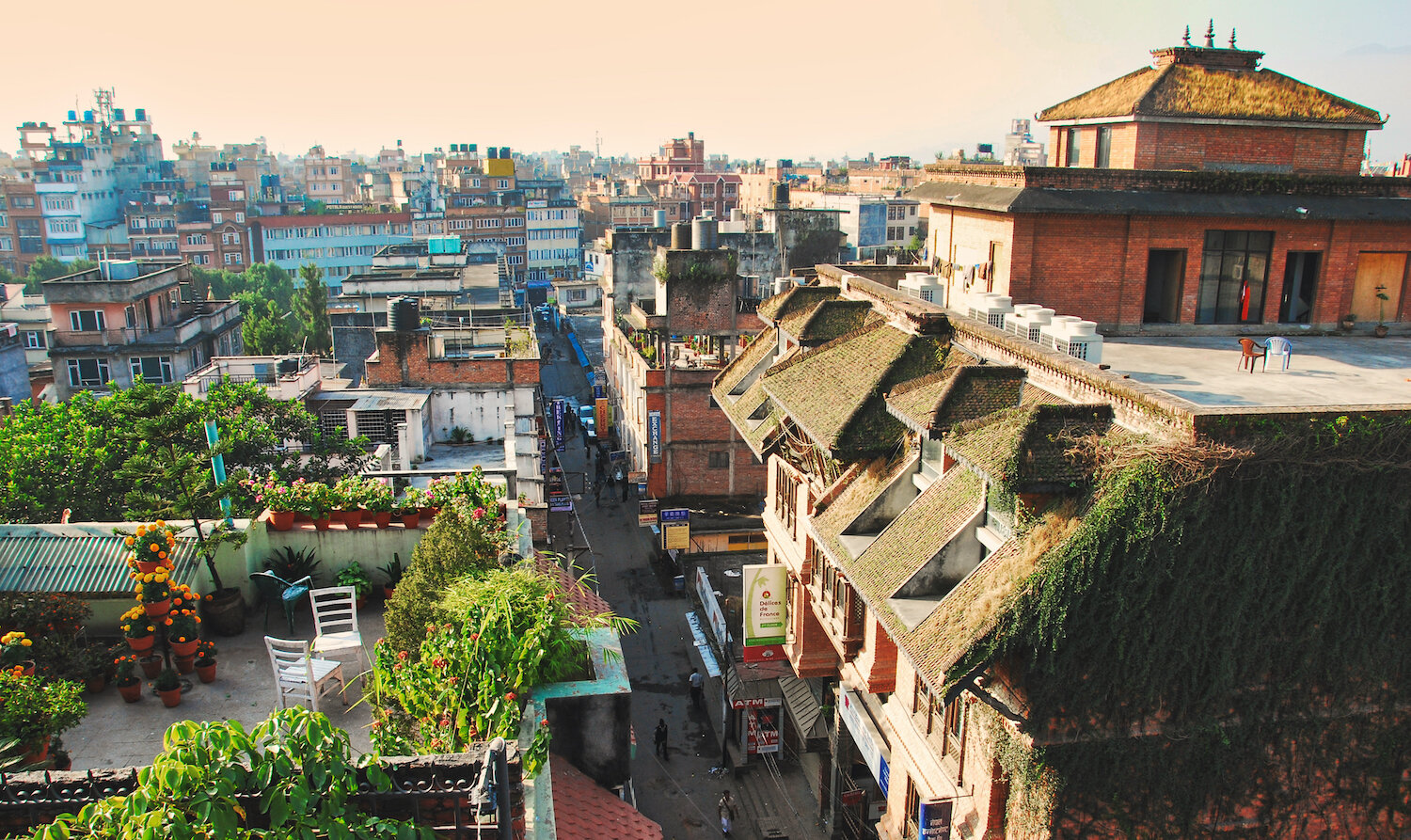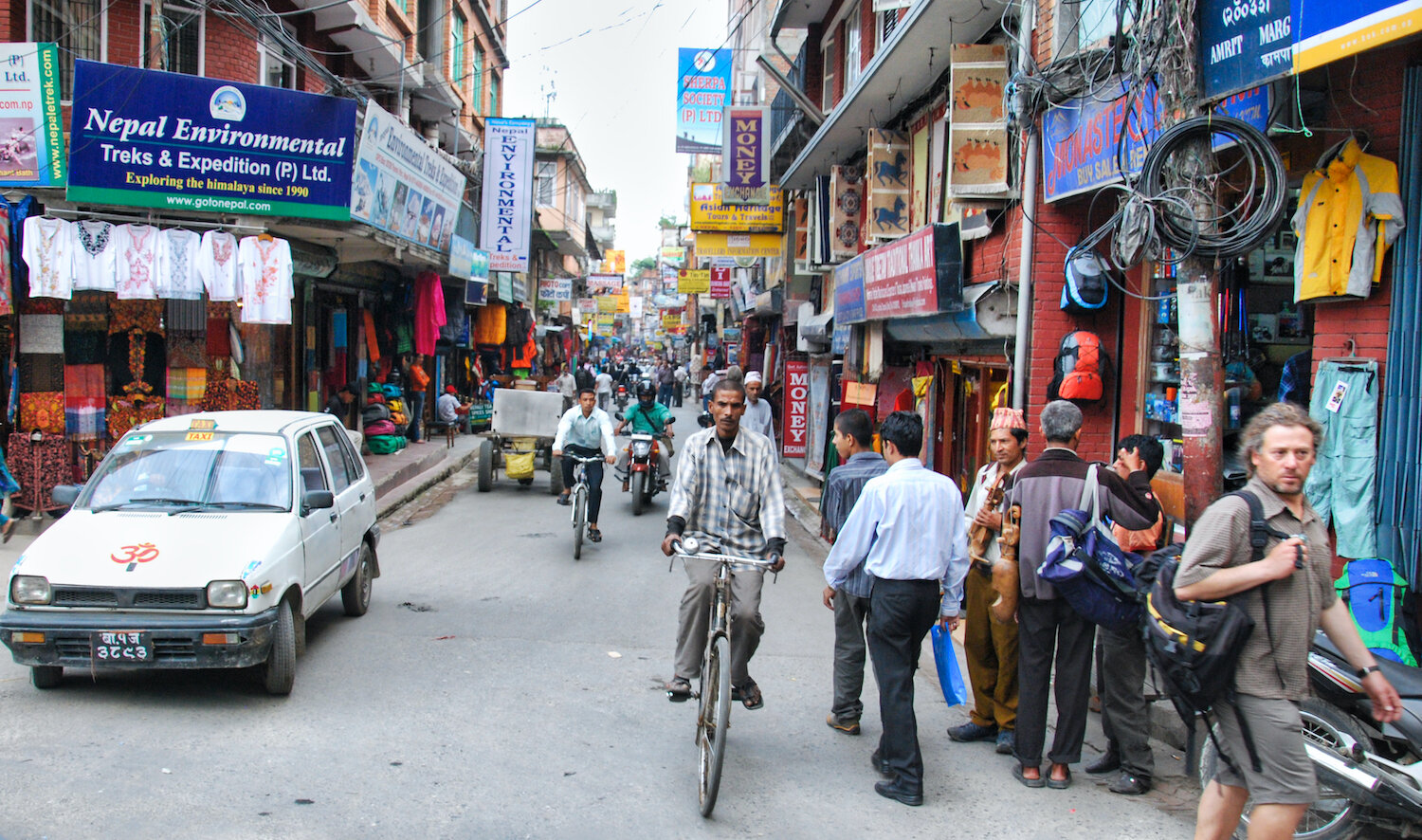86 - Sugarplums (Thamel, Kathmandu, Nepal)
OUR HOME IS OPEN TO GOD, GUESTS, FRIENDS, AND SUNSHINE. (This on the Hotel Ganesh website in Kathmandu.) Sounded lovely… Nepal beckoned. I responded. I cut my Vietnam sojourn short by almost two months. It was becoming a slog, so I hit eject and settled on the roof of the world. Hanoi–Bangkok–Kathmandu. Wise decision. Nepal was on my bucket list, and I wasn’t getting any younger. I would spend four months there—four of the best months of my goddamn life. You can quote me.
Visions of sugarplums danced in my head. And by “sugarplums,” I mean pristine trails, azure skies, snow-capped juggernauts, tigers and rhinos and leopards, oh my. I didn’t know what I would do, or how I would do it. I kept research to a minimum, deciding to investigate in person. Sky’s the limit… literally.
Upon arrival, two things became abundantly clear: I was going to like it there; I would probably go bankrupt. What happens when two planes of Gore-Tex toting tourists disembark simultaneously? You wait two hours for a visa. This did not dampen my fervor. That was impossible. Namaste and all that shit, ya know? Though I was itching to get the party started, I tempered my enthusiasm in the interest of prudence. Rest, relaxation, investigation, and invigoration. So, I took a few personal days.
Kathmandu is barely controlled chaos in a sprawling cityscape of brick and concrete multi-storied buildings rising and falling like an ill-conceived Lego megalopolis. Not so pretty to look at and air pollution doesn’t quite gel with the Himalayan flavor. A certain allure attaches, but it wears off fast. Thamel is the tourist ghetto de jure; the logistical gateway to adventure. If you can avoid it, do so. My day-to-day needs varied, so I couldn’t eschew the convenience. Book stores, tour offices, internet cafés, food marts, guesthouses, restaurants—it’s the epicenter of preparation. Perhaps, Thamel means “necessary evil” in Nepali.
Since the end of the Maoist rebellion, Nepal had been courting tourists aggressively. In fact, the government was planning an upcoming “Year of the Tourist.” I was more than a little thankful I’d beat the rush. How enthusiastic were they? Well, enthusiastic enough to grant a three-month visa-on-arrival at the airport. Three months? All the time in the world, right? Wrong. Not with my dream agenda. Trekking permutations alone could occupy a lifetime. And then there’s rafting, paragliding, parahawking (shadowing a hawk while paragliding), bungee jumping, canyoning, meditation retreating… you get the idea.
Get high or low. As you wish. Yetis and snow leopards on the roof. Tigers, rhinos, and elephants on the floor (i.e. jungle). Throw in fascinating religious/cultural wormholes, and you realize a single human lifespan is grossly inadequate. And what of nearby Tibet and the Kingdom of Bhutan? It was time to batten down the hatches.
I got my bearings and booked a warm-up trek in Kathmandu’s surrounding “hills.” All that time at sea level didn’t lend itself to storming the Himalayas. I deemed it wise to ease into the scene. Four-day itinerary: Sundarijal-Chisopani-Nagarkot-Dhulikel. Not too far. Not too strenuous. ’Twas the season for rafting, so the day after I returned, I’d be off on a nine-day whitewater extravaganza. Two days in Nepal, and I was already getting carried away. Giddy as a schoolgirl on nitrous. Pack it up, pack it in, let me begin…
Nepal’s open invitation was rooted in tragedy. The country played musical governments for the twenty years preceding my advent. When the music stopped, the Federal Democratic Republic of Nepal emerged—a long and winding road with a ten-year civil war thrown in for good measure. Tourism took a serious shit. Trails were empty. Businesses suffered. I remember reading about the turmoil and thinking, I should go there right now if I could. I couldn’t. Super cheap. No crowds. Tons of appreciation. Sure, you might get caught between Maoist rebels and a hard place, but it wasn’t as dangerous as news outlets and government websites (here’s looking at you, US State Department) led wayfarers to believe. Getting shot in the face was more about bad timing and worse luck, not about animus towards foreigners.
Even the guerrillas understood the economic importance of tourism, the figurative bread and butter of the proletariat. I heard countless stories about tourists stopped on a trail “convinced” to donate to the cause. Extortion? Sure. Ideal? Nope. But the “fee” was reasonable, and the extorted were routinely given receipts so they wouldn’t have to pay twice. The biggest obstacles were logistical headaches related to strikes, demonstrations, and the occasional crossfire hijinks. Shackled by debt and military service, I was forced to fantasize from afar… sigh.
Nepal to investigate civil war crimes
26 August 2016 — BBC — Phanindra Daha.
The two commissions set up to investigate crimes committed during Nepal's civil war have received nearly 57,000 submissions, but many victims are sceptical about getting justice. The United Nations has already said it will not support the process as it does not meet international standards so what hope is there for reconciliation?…READ MORE
Nepal: The Maoist dream
AL JAZEERA
In the suburbs of Nepal’s capital, Kathmandu, a woman tends to vegetables in the farm that surrounds the humble tin-roofed home she shares with two former comrades-in-arms.
Spring is just around the corner and flowers have started to blossom in these fields, over which snow-capped mountains loom.
Sharma’s gaze drifts off towards the peaks. The 34-year-old…READ MORE
So, I had to settle for peace and relative stability, though I did encounter revolutionary artifacts (banners and graffiti) along the way. In 2006, the Maoists laid down their weapons and joined the government. No more monarchy. New constitution (eventually). All’s well that ends well… not even close. With rural communities enfranchised, a former Maoist rebel became prime minister (twice) making Nepal one of only two countries to elect a communist leader democratically. (Cyprus is the other.)
The transition was, and still is, a rocky one. The usual suspects—political and social dynamics—are in play. Voting on that constitution only took eleven years. Patriots became sellouts and traitors to the diehards (i.e. Maoist politicians did too much politicking). Can the price of peace ever be too high? Apparently so. Factions have risen with calls to re-arm and continue the struggle. And there’s never been an accounting of all the atrocities committed by both sides. Yes, it’s a shitshow, but at least it’s a political one for now.
If all that wasn’t enough, the country suffered through a devastating earthquake in 2015, followed by an intense aftershock a month later. Almost 9,000 dead. Over 22,000 casualties. Nearly 3.5 million homeless. And a shitload of property damage. Suffice it to say, it’s been a rough few decades for Nepal.
Learning from disasters: Nepal copes with coronavirus pandemic 5 years after earthquake
The Conversation - April 23, 2020 2.59pm EDT
Does one kind of disaster prepare us for another? Five years after devastating earthquakes struck, Nepali citizens and their government are pondering this question while under lockdown due to the coronavirus pandemic. After the earthquakes in 2015, nearly 9,000 people died, while more than 800,000 lost their homes and 2.8 million were displaced. In many rural areas, the earthquakes compounded the effects of a decade-long civil war that ended in 2006 but left the country in a period of protracted political instability…READ MORE
Earthquake Aftershocks Jolt Nepal as Death Toll Rises Above 3,400
By Thomas Fuller and Chris Buckley - April 26, 2015
The New York Times
KATMANDU, Nepal — Each time this city shuddered with aftershocks from the earthquake that convulsed Nepal, Samaj Gautam felt an urge to join the millions of residents who fled to safety outdoors. But working in a hospital emergency ward inundated with the wounded, and their broken limbs, fractured skulls and other physical traumas, Dr. Gautam said Sunday night, he and his colleagues had to…READ MORE






















